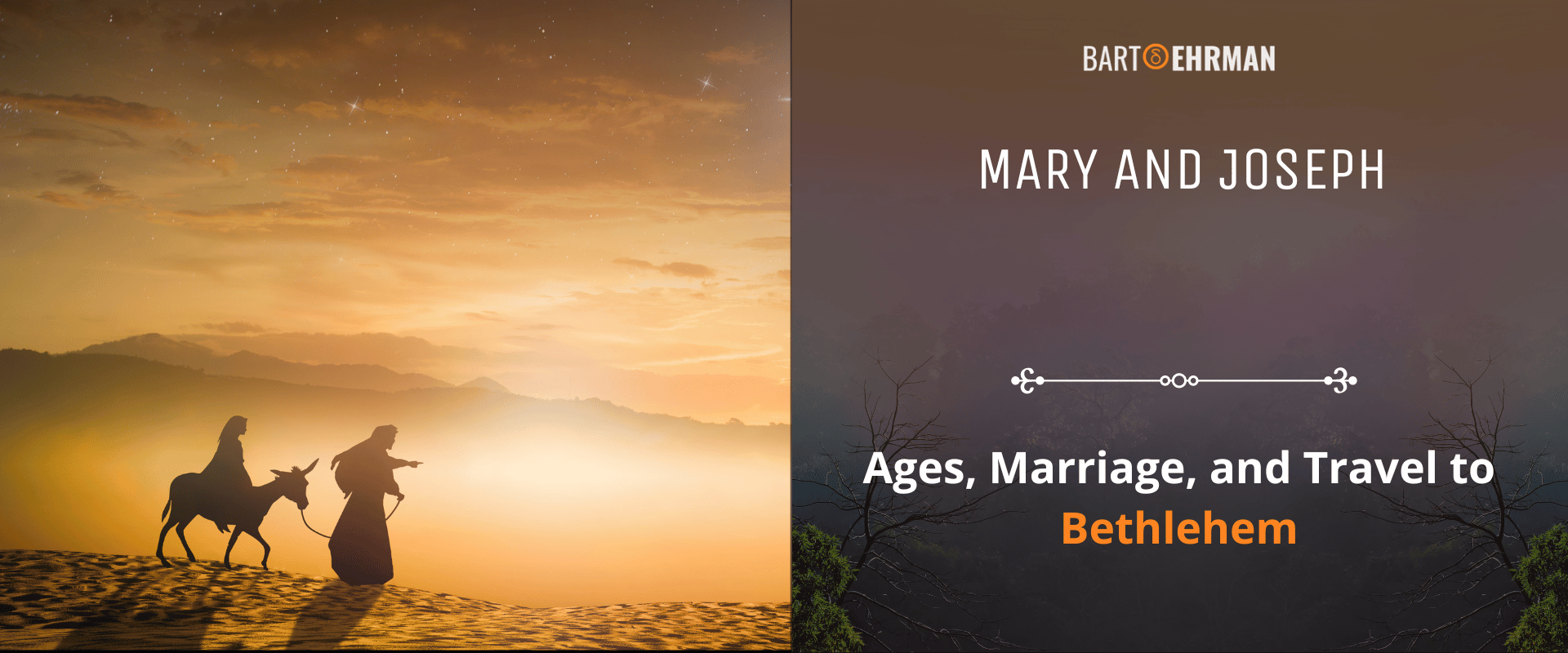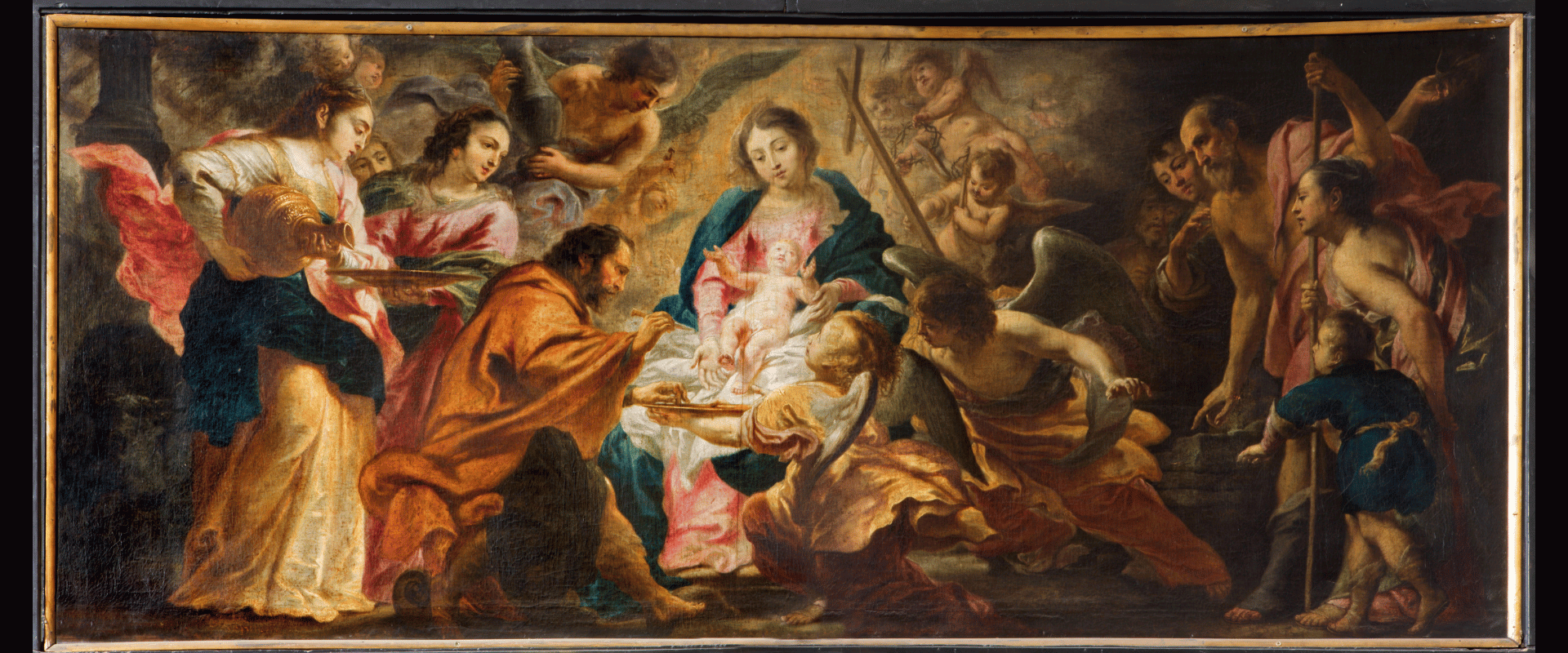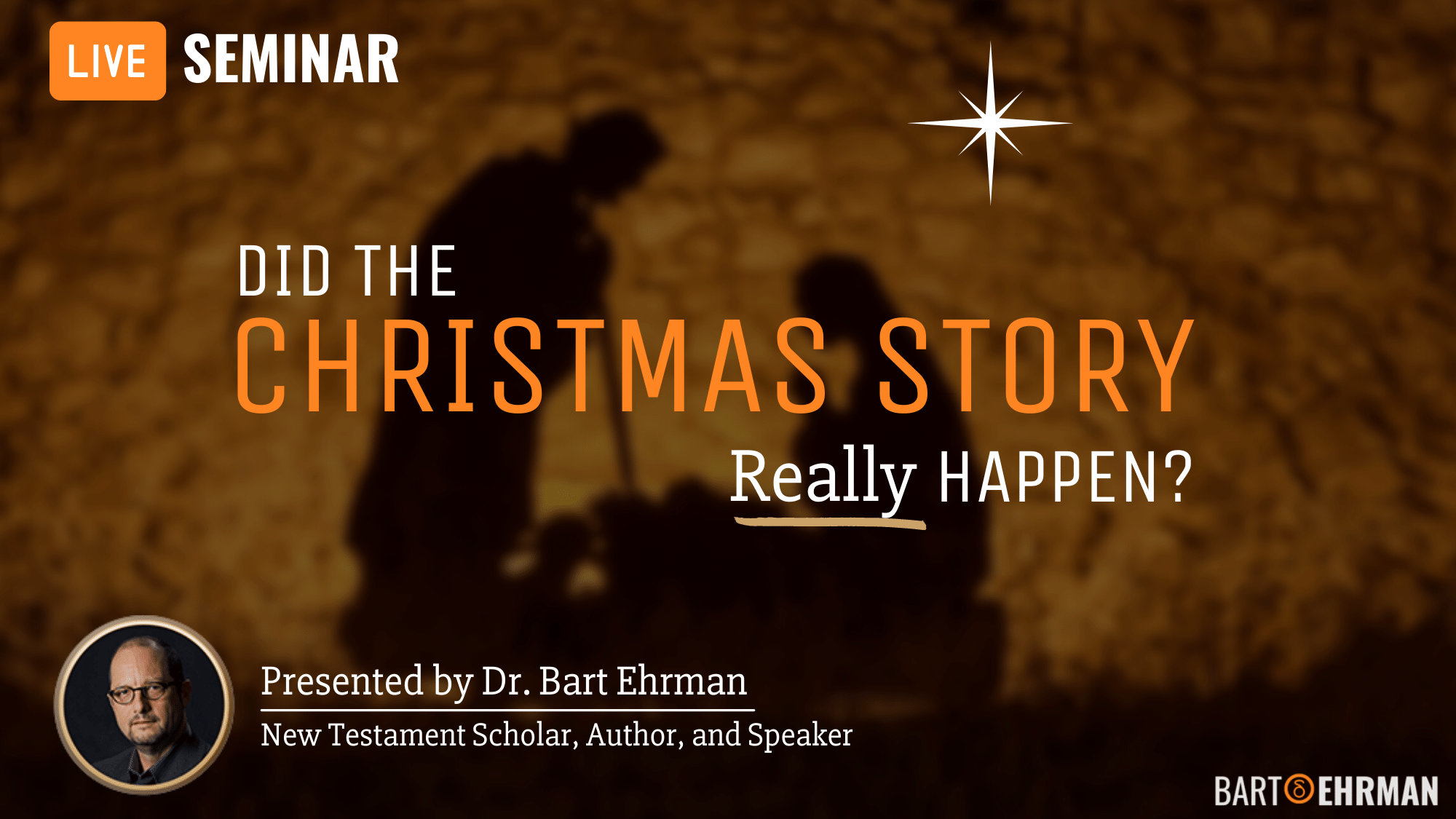Mary and Joseph: Ages, Marriage, and Travel to Bethlehem

Written by Joshua Schachterle, Ph.D
Author | Professor | Scholar
Author | Professor | BE Contributor
Verified! See our editorial guidelines
Verified! See our guidelines
Edited by Laura Robinson, Ph.D.
Date written: December 14th, 2023
Disclaimer: The views and opinions expressed in this article belong to the author and do not necessarily match my own. - Dr. Bart D. Ehrman
What can we really know about Mary and Joseph, Jesus’ parents? Like most figures from ancient times, they are difficult to pin down. How much of the Gospel stories about them are historically reliable? In this article, I’ll look at information about Mary and Joseph from the Gospels and apocryphal literature and combine it with what we know of the history and culture of 1st-century Palestine to create as clear a picture of them as I can.

Mary and Joseph in the Gospels
Luke 1:26-38 says this about Mary and her pregnancy with Jesus:
26 In the sixth month the angel Gabriel was sent by God to a town in Galilee called Nazareth, 27 to a virgin engaged to a man whose name was Joseph, of the house of David. The virgin’s name was Mary. 28 And he came to her and said, “Greetings, favored one! The Lord is with you.”[b] 29 But she was much perplexed by his words and pondered what sort of greeting this might be. 30 The angel said to her, “Do not be afraid, Mary, for you have found favor with God. 31 And now, you will conceive in your womb and bear a son, and you will name him Jesus. 32 He will be great and will be called the Son of the Most High, and the Lord God will give to him the throne of his ancestor David. 33 He will reign over the house of Jacob forever, and of his kingdom there will be no end.” 34 Mary said to the angel, “How can this be, since I am a virgin?”[c] 35 The angel said to her, “The Holy Spirit will come upon you, and the power of the Most High will overshadow you; therefore the child to be born[d] will be holy; he will be called Son of God. 36 And now, your relative Elizabeth in her old age has also conceived a son, and this is the sixth month for her who was said to be barren. 37 For nothing will be impossible with God.” 38 Then Mary said, “Here am I, the servant of the Lord; let it be with me according to your word.” Then the angel departed from her.
Matthew 1:18-25 puts it this way:
18 Now the birth of Jesus the Messiah took place in this way. When his mother Mary had been engaged to Joseph, but before they lived together, she was found to be pregnant from the Holy Spirit. 19 Her husband Joseph, being a righteous man and unwilling to expose her to public disgrace, planned to divorce her quietly. 20 But just when he had resolved to do this, an angel of the Lord appeared to him in a dream and said, “Joseph, son of David, do not be afraid to take Mary as your wife, for the child conceived in her is from the Holy Spirit. 21 She will bear a son, and you are to name him Jesus, for he will save his people from their sins.” 22 All this took place to fulfill what had been spoken by the Lord through the prophet:
23 “Look, the virgin shall become pregnant and give birth to a son, and they shall name him Emmanuel,”
which means, “God is with us.” 24 When Joseph awoke from sleep, he did as the angel of the Lord commanded him; he took her as his wife 25 but had no marital relations with her until she had given birth to a son, and he named him Jesus.
Both stories make special mention of the fact that Mary was a virgin. Where did this notion come from? Matthew quotes a prophecy which comes from Isaiah 7:14. However, the idea of the virgin birth may have come from a simple mistranslation of one word in the prophecy.
All the authors of the New Testament read the Hebrew Bible not in its original Hebrew language but in Greek. This Greek translation was called the Septuagint. Like all translations, the Septuagint sometimes made mistakes. The prophecy in its original Hebrew says “Look, the almah shall become pregnant and give birth to a son.” The Hebrew word almah simply means “young woman.”
When the Greek-speaking translators came across that word, they mistranslated it, using the Greek word parthenos, which indeed means “virgin.” So, when Matthew and Luke (or their sources) were writing their Gospels, they looked to the Hebrew Bible for prophecies concerning Jesus and found a reference to what they thought was a virgin becoming pregnant. This accorded with their idea of Jesus as God’s son so they used it as evidence that Jesus was the Messiah.
Given this fact, it is historically likely that Jesus was simply Mary and Joseph’s firstborn son.
Oh, Little Town of Bethlehem
While the Gospels of Mark and John have no birth stories of Jesus, both Matthew and Luke agree that Jesus was born in the town of Bethlehem. However, many of our earliest sources about Jesus call him Jesus of Nazareth and acknowledge that he was raised in the town of Nazareth. Why would Mary and Joseph have gone to Bethlehem for Jesus’ birth?
Again, Matthew quotes the relevant prophecy from the Hebrew Bible, this time from Micah 5:2:
6 ‘And you, Bethlehem, in the land of Judah,
are by no means least among the rulers of Judah,
for from you shall come a ruler
who is to shepherd my people Israel.’ ”
For both Matthew and Luke, as well as other Jewish traditions, the Messiah would be born in Bethlehem like King David. The Gospel writers had to come up with a story to get Mary and Joseph to Bethlehem from Nazareth.
Actually, Matthew just says Jesus was born in Bethlehem without any explanation at all. Luke 2:1-7, however, says this:
2 In those days a decree went out from Caesar Augustus that all the world should be registered. 2 This was the first registration and was taken while Quirinius was governor of Syria. 3 All went to their own towns to be registered. 4 Joseph also went from the town of Nazareth in Galilee to Judea, to the city of David called Bethlehem, because he was descended from the house and family of David. 5 He went to be registered with Mary, to whom he was engaged and who was expecting a child. 6 While they were there, the time came for her to deliver her child. 7 And she gave birth to her firstborn son and wrapped him in bands of cloth and laid him in a manger, because there was no place in the guest room.
There are several historical problems with this story. First, Caesar Augustus did take censuses in order to be able to tax the citizens of his empire. However, Quirinius was governor of Syria from 6-7 CE, years that Caesar did not take a census.
In addition, most scholars agree that Jesus, meanwhile, was born between 6 and 4 BCE. The dates Luke establishes around the census don’t match.
Second, a census never required sending everyone to their ancestral cities. Had the emperor required this, it would have crippled the economy, stopping everyone’s production of food and other products while they all traveled slowly (it was the ancient world, after all!) to their ancestral cities and back.
Third, the distance from Nazareth to Bethlehem is almost 100 miles. Mary and Joseph were not wealthy, so they would have been on foot or with the pregnant Mary possibly riding a donkey. Imagine a journey of 100 miles, at least 35 hours of total walking or riding, while you are pregnant with delivery imminent.
Most scholars agree that for Luke, the story of the census is merely a plot device to get the pregnant Mary to Bethlehem to confirm that Jesus was the Messiah. It is far more historically likely that Jesus was born in Nazareth and spent his entire childhood there.
FREE COURSE!
WHY I AM NOT A CHRISTIAN
Raw, honest, and enlightening. Bart's story of why he deconverted from the Christian faith.
Over 6,000 enrolled!
The Slaughter of the Innocents
According to Matthew 2:13-18, Mary, Joseph, and the infant Jesus were then sent on another journey:
13 Now after [the magi, or wise men] had left, an angel of the Lord appeared to Joseph in a dream and said, “Get up, take the child and his mother, and flee to Egypt, and remain there until I tell you, for Herod is about to search for the child, to destroy him.” 14 Then Joseph got up, took the child and his mother by night, and went to Egypt 15 and remained there until the death of Herod. This was to fulfill what had been spoken by the Lord through the prophet, “Out of Egypt I have called my son.”
16 When Herod saw that he had been tricked by the magi, he was infuriated, and he sent and killed all the children in and around Bethlehem who were two years old or under, according to the time that he had learned from the magi. 17 Then what had been spoken through the prophet Jeremiah was fulfilled:
18 “A voice was heard in Ramah,
wailing and loud lamentation,
Rachel weeping for her children;
she refused to be consoled, because they are no more.”
Again, we have to address historical problems in this story. First, it’s only told in Matthew. Did the other Gospel authors not know about such a horrific event? There are also no other historical sources for this story, indicating that it probably never happened.
Most scholars believe that the story is Matthew’s invention, meant to correspond to a similar event in the life of Moses when Pharaoh kills all Israelite babies but Moses escapes. For Matthew, Jesus is the new Moses, as we see during his discourse on the Torah in the Sermon on the Mount.
Second, if Mary and Joseph had been in Bethlehem, the journey to Egypt – the border would have been about 40 miles away – would have taken them several days, again on foot. If Mary were still recovering from giving birth and Jesus was a newborn, such a journey would have been all but impossible.
In addition, if we also accept the scholarly consensus that the Slaughter of the Innocents never happened, the journey to Egypt would have been entirely unnecessary.
Only the Gospel of John says explicitly that Mary was at Jesus’ crucifixion in a scene in which Jesus asks the Beloved Disciple to care for her after his death. While this is not impossible, the fact that the other Gospels don’t have the same story makes it a bit less likely to have happened.
That’s basically all the information we get about Mary and Joseph in the Gospels. What else can we know about them?
Mary and Joseph’s Marriage: What Was Marriage Like in 1st-century Palestine?
While the Gospels never explicitly say that Mary and Joseph married before Jesus’ birth, 1st-century readers would have assumed that if they had lived together, traveled together and raised a child together as it says in the Gospels, they must have been married.
To understand Mary and Joseph’s marriage, we need to understand the marital customs and traditions from their time and place.
In 1st-century Palestine, the ideal age for marriage, for both women and men, was during late adolescence. Men, however, often married a bit later, sometimes even as late as 30. We can probably assume, therefore, that when they married, Mary was between 14 and 19 years old while Joseph may have been in his 20s.
Bruce Malina writes this about marriage in the 1st-century world:
During the initial phase, the prospective spouses are set apart for each other; they are betrothed. The responsible males [fathers of the bride and groom] draw up a marriage contract, and eventually the bride’s father must surrender his daughter to the groom, who takes a wife by bringing her into his house [with his parents].
The bride’s family looks for a groom who will be a good provider, a kind father, and a respected citizen. The bride does not look to him for companionship or comfort… The new wife will not be integrated into her husband’s family, but will remain for the most part of her life on the periphery of the husband’s family.
Note that husbands and wives were not required to have a close relationship. This doesn’t mean that they couldn’t be close, just that it was not a necessity of marriage as it is considered today. Instead, marriage was an economic arrangement, meant to bring together two families for economic purposes.
If indeed Mary had been pregnant before their marriage, Joseph’s family, if they were alive, would likely have canceled the marriage since a pregnant bride would have been considered less valuable. The fact that neither Joseph nor his family does this in the Gospels is surely meant to show that Joseph was a kind person. It is likely, then, that they got married before Jesus’ birth.
Since the Gospels don’t say anything about Mary or Joseph’s parents, there are two possibilities: First, both Mary and Joseph’s parents might have been dead. Life expectancy, especially for the poor, was very low.
Second, Mary and Joseph might have moved to Nazareth from some other surrounding town. This is less likely since, as Malina notes, most people remained all their lives in the place where they had grown up.

A Biography of Mary: The Protoevangelium of James
While the Gospels give us almost no information about Mary and Joseph’s upbringing, there is a much later text, The Protoevangelium of James, that claims to include a biography of Mary (“protoevangelium” means “proto-Gospel,” indicating that it’s a kind of prequel to the Gospels). This text was written almost a century after the Gospels, so its value as a historical source is dubious. However, it does contain some interesting ideas.
According to the text, Mary was the daughter of Joachim and Anna, a righteous couple who were unable to conceive until their desperate prayers for a child were answered. In response to her miraculous pregnancy, Anna dedicates Mary to God and vows that she will be raised in the Temple.
If this sounds familiar, it should: this story is almost identical to the story of the prophet Samuel in 1 Samuel, chapter 1. No doubt the author of this text did this intentionally, showing why Mary, like the prophet Samuel, was a pure servant of God and was therefore worthy of giving birth to Jesus.
Mary is raised in the Temple until she is 12, when the priests tell her she can’t stay in the Temple any longer since she is becoming a young woman. At this point, God brings Joseph, an elderly widower, to be her guardian. In other words, he is not only old but also not Mary’s husband. For this author, this explains why Joseph could not have had sexual relations with Mary, confirming Jesus’ birth of a virgin.
This seems to be the beginning of the notion of the perpetual virginity of Mary. This is the idea that not only did Mary not conceive Jesus through sexual intercourse, but that she also never had sex even after that. Joseph is said, in the Protoevangelium of James, to have had other children through a first marriage, which explains Jesus having brothers and sisters.
Most scholars don’t believe any of this to be historical, although it is interesting as a source of later Christian devotion to Mary.
Finally, Mary is mentioned later in Acts 1:14 as part of the Jesus-following community, which included the 12 apostles and Jesus’ brothers. It says that after Jesus’ death,
All these were constantly devoting themselves to prayer, together with certain women, including Mary the mother of Jesus, as well as his brothers.
This is the last we hear about Mary’s life.
What Do We Know About Joseph’s Upbringing?
Unfortunately, we have even less information about Joseph. In Matthew, we are told that Jesus was called “the son of the carpenter.” The Greek word translated as carpenter is tekton. John Dominic Crossan writes that while we think of a carpenter as a highly-skilled and trained professional, the word in ancient Greek is more similar to “day-laborer.” This marks Joseph as poor and coming from a poor family.
It has been noted that Joseph is not mentioned in the Gospels after the story about Jesus being forgotten at the Temple in Luke 2:41-52. Later interpreters would assume from this that Joseph had died when Jesus was very young, which is certainly plausible.
Conclusion: What Can We Know about Mary and Joseph?
Mary and Joseph would have gotten married in their teens or 20s, with Joseph more likely to be a little older. Legends about Joseph being elderly and merely the guardian of Mary were invented later to reinforce the notion of Mary’s virginity and thus Jesus’ messiahship.
Despite what the Gospels say, it is more historically likely that they were both from Nazareth and that they were betrothed by their parents or other older relatives for economic reasons. They probably spent their lives living in Nazareth and raising their children.
Joseph was likely a kind of day-laborer, cobbling together the best living he could by working at whatever menial jobs were available. He may have died when Jesus was young.
Mary likely lived for several years after the death of Jesus and became part of the community gathered around the life and teachings of her son. She was there at the beginning of Jesus’ life and remained, still devoted to him, after his death.

